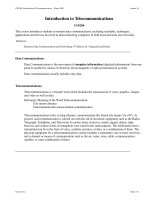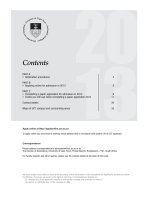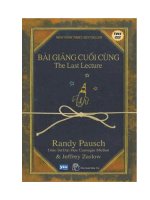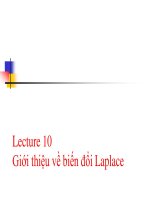Lecture no20 applying annaul worth
Bạn đang xem bản rút gọn của tài liệu. Xem và tải ngay bản đầy đủ của tài liệu tại đây (760.37 KB, 14 trang )
Applying Annual Worth
Analysis
Lecture No. 20
Chapter 6
Contemporary Engineering Economics
Copyright © 2016
Contemporary Engineering Economics, 6 th edition
Park
Copyright © 2016 by Pearson Education, Inc.
All Rights Reserved
Where to Apply the AE Analysis
• Unit cost (or profit)
calculation
• Outsourcing (makebuy) decision
• Pricing the use of an
asset
Contemporary Engineering Economics, 6 th edition
Park
Copyright © 2016 by Pearson Education, Inc.
All Rights Reserved
Unit Cost (Profit) Calculation
• Step 1: Determine the number of units (annual
volume) to be produced (or serviced) each year
over the life of the asset.
• Step 2: Determine the annual equivalent cost (or
worth) of owning and operating the asset.
• Step 3: Divide the equivalent cost (worth) by the
annual volume.
Contemporary Engineering Economics, 6 th edition
Park
Copyright © 2016 by Pearson Education, Inc.
All Rights Reserved
Example 6.5: Unit Profit per Machine Hour When
Annual Operating Hours Remain Constant
Project Cash Flows and Operating
Hours
Contemporary Engineering Economics, 6 th edition
Park
Copyright © 2016 by Pearson Education, Inc.
All Rights Reserved
Solution
• Step 1: Determine the annual
volume.
• Project Cash Flows and Operating
Hours
• 3,000 hours per year
• Step 2: Obtain the equivalent
annual worth.
• PW (12%) = $30,065
• AE (12%) = $30,065 (A/P, 12%, 4)
= $9,898
• Step 3: Determine the unit profit
(savings per machine hour).
Savings per machine hour
= $9,898/3,000
= $3.30/hour
Contemporary Engineering Economics, 6 th edition
Park
Copyright © 2016 by Pearson Education, Inc.
All Rights Reserved
Example 6.6: Unit Profit per Machine Hour When
Annual Operating Hours Fluctuate
Contemporary Engineering Economics, 6 th edition
Park
Copyright © 2016 by Pearson Education, Inc.
All Rights Reserved
Solution
• Step 1: Determine the annual
volume.
Year 1: 3,500 hours
• Year 2: 4,000 hours
• Year 3: 1,700 hours
• Year 4: 2,800 hours
•
Step 3: Determine the unit profit
(savings per machine hour)
C = $9,898/3,062.95
= $3.23/hour
• Step 2: Obtain the equivalent
annual worth.
AE (12%) = $30,065 (A/P, 12%, 4) = $9,898
C[(3,500)(P/F,12%,1) + (4,000)
(P/F,12%,2) + (1,700)(P/F,12%,3) +
(2,800)(P/F,12%,4)] x (A/P,12%,4) =
3,062.95C
Contemporary Engineering Economics, 6 th edition
Park
Copyright © 2016 by Pearson Education, Inc.
All Rights Reserved
Make or Buy Decision
• Step 1: Determine the time span (planning horizon)
for which the part (or product) will be needed.
• Step 2: Determine the annual volume of the part (or
product).
• Step 3: Obtain the unit cost of purchasing the part (or
product) from an outside firm.
• Step 4: Determine the equipment, manpower, and all
other resources required to make the part (or
product).
Contemporary Engineering Economics, 6 th edition
Park
Copyright © 2016 by Pearson Education, Inc.
All Rights Reserved
• Step 5: Estimate the net cash flows associated with
the “make” option over the planning horizon.
• Step 6: Compute the annual equivalent cost of
producing the part (or product).
• Step 7: Compute the unit cost of making the part
(or product) by dividing the annual equivalent cost
by the required annual volume.
• Step 8: Choose the option with the minimum unit
cost.
Contemporary Engineering Economics, 6 th edition
Park
Copyright © 2016 by Pearson Education, Inc.
All Rights Reserved
Example 6.7: Outsourcing Production
of Electric Compressors
Investment and Other
Financial Date Related to
Outsourcing
• Electric compressor: $42 per
unit
• Required investment:
$325,000
• Salvage value: $60,000
• Service life: 7 years
• Annual maintenance cost:
$120,000
• MARR: 18%
Contemporary Engineering Economics, 6 th edition
Park
Copyright © 2016 by Pearson Education, Inc.
All Rights Reserved
Solution
Contemporary Engineering Economics, 6 th edition
Park
Copyright © 2016 by Pearson Education, Inc.
All Rights Reserved
Pricing the Use of an Asset
• The cost per square foot for owning and operating
a real property (example, user fee)
• The cost of using a private car for business (cost
per mile)
• The cost of flying a private jet (cost per seat)
• The cost of using a parking deck (cost per hour)
Contemporary Engineering Economics, 6 th edition
Park
Copyright © 2016 by Pearson Education, Inc.
All Rights Reserved
Example 6.8: Pricing an Apartment Rental Fee
Investment Problem: Building a 50-unit apartment
complex
o Land investment cost = $1,000,000
o Building investment cost = $2,500,000
o Annual upkeep cost = $150,000
o Property taxes and insurance = 5% of
o
o
o
o
total investment
Occupancy rate = 85%
Study period = 25 years
Salvage value = Only land cost can be
recovered in full
Interest rate = 15%
At Issue: How to price the monthly rental per
unit?
Contemporary Engineering Economics, 6 th edition
Park
Copyright © 2016 by Pearson Education, Inc.
All Rights Reserved
Solution
• Ownership cost
CR(15%) ($3,500,000 $100,000)( A / P ,155,25)
($100,000)(0.15)
$401,749
• Annual O&M Cost
• Total Equivalent Annual Cost
• Required Monthly Charge
O&M cost = (0.05)($3,500,000) + $150,000
= $325,000
AEC(15%) $401,749 $325,000
$726.749
$726,749
Required monthly charge =
(12 50)(0.85)
$1,425
Contemporary Engineering Economics, 6 th edition
Park
Copyright © 2016 by Pearson Education, Inc.
All Rights Reserved









